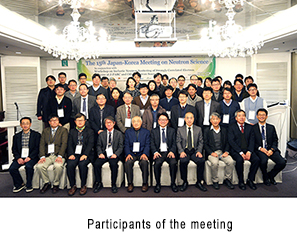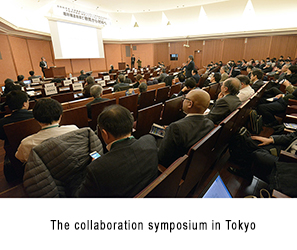| Ā° J-PARC News - January 2016 (Issue #129) |
| Āú3rd Accelerator Facility Safety Symposium (January 27-28, Advanced Science Research Center, Nuclear Science Research Institute of Japan Atomic Energy Agency ) |
|---|
| Due to the lessons learned from the radioactive material leak accident at the Hadron Experimental Facility, the J-PARC Center appeals to staff in charge of safety at accelerator facilities and universities both inside and outside Japan, and holds a safety symposium every year to exchange information and discuss efforts for ensuring facility safety and related matters. In this year, the symposium focused on the topic of the management of radioactivity induced in accelerator components of accelerator facilities and safety management at high-pressure gas facilities. The participants were about 150 concerned people from Japan, and in addition to oral presentations, facilities and other topics were introduced through poster presentations, and the attendees deepened their mutual understanding and had discussion regarding safety issues at accelerator facilities. |
| The first day began with an opening greeting by Naohito Saito, Director of the J-PARC Center, and on the first theme "Radiation Safety and the management of Radioactivity induced in accelerator components of Accelerator Facilities". Eight research institutions including J-PARC presented efforts at their accelerator facilities. The theme for the 1st Ā@session in the second day was "Safety Measures for Low-Temperature Equipment and High-Pressure Gas Equipment at Accelerator Facilities," and there were reports on safety efforts regarding the superconducting magnet systems of the J-PARC Neutrino Experimental Facility, and measures to prevent oxygen deprivation when handling SF6 gas at the Tandem Accelerator of the Nuclear Science Research Institute. In the next session of "Efforts toward Safety at Research Institutions and Universities," there were presentations on safety efforts at the National Institute for Fusion Science, Osaka University and the Brookhaven National Laboratory (BNL) in the USA. After the oral sessions were finished, there was a tour of J-PARC's Materials and Life Science Experimental Facility (MLF) , and the symposium was brought to a close. |
| |
| Ā£to Page Top |
| |
|
| Āú Held 21st J-PARC PAC (January 13-15, J-PARC Research Building) |
|---|
| The J-PARC Program Advisory Committee (J-PARC PAC) was recently held with 12 invited members, including six from overseas. This committee evaluates and assesses proposals for elementary particle and atomic nucleus experiments, primarily using the MR (50 GeV synchrotron) of J-PARC. At this meeting, the committee reported on the current status and future prospects of J-PARC facilities, checked progress of the proposals currently being conducted at the neutrino and hadron facilities, and evaluated adoption of new experimental proposals. During open presentations held from the first day to the afternoon of the second day, many users and facility staff filled the venue, and listened to the announcements on each proposal. |
| |
| Ā£to Page Top |
| |
|
| Ā° 15th Korea-Japan Meeting on Neutron Science (January 6-8, Busan, South Korea) |
|---|
| These Korea-Japan Meetings on Neutron Science began with exchanges between the High-Flux Advanced Neutron Application Reactor (HANARO) of the Korea Atomic Energy Research Institute (KAERI) and the KEK Pulsed Spallation Neutron Source (KENS) of the High Energy Accelerator Research Organization (KEK). These international conferences are held every year, hosted alternately by Japan and Korea, to discuss neutron scattering instruments and research utilizing them. In August 2010, Korea established the Center for Korean J-PARC Users (CKor J-PARC) as an organization within Seoul National University to promote and facilitate experiments using neutrons at J-PARC, and a Memorandum of Collaboration was signed with the J-PARC Center in October 2010. |
| At this meeting, there were 45 participants from Korea and 27 participants from Japan, and the meeting on the 7th began with a greeting by Professor Sung-Min Choi of the Korea Advanced Institute of Science (KAIST), acting as representative of the Korean side which hosted this meeting. At the meeting, there were 30 oral presentations and 26 poster presentations. In the oral presentations, researchers from the two countries exchanged information regarding all aspects of neutron experiments, including reports on the situation of joint research results, reports on the MLF, J-RR3 and HANARO neutron experimental facilities, and an overview of research progress over the last year. In the poster presentation segment, Ms. Mariko Isono of Nagoya University received an award for her outstanding poster presentation. At the end of the conference, there was a summary report, and closing remarks by Professor Sungkyun Park of Pusan National University (PNU). |
| At the business meeting held on the 7th, it was discussed that every opportunity would be exploited to advance research cooperation between Japan and Korea, and regarding future meetings, it was decided that in 2017 there will only be a business meeting because the ICNS (International Conference on Neutron Scattering) will be held in Korea, and the next research meeting will be held in 2018 in Japan. |

 * Click here to enlarge. * Click here to enlarge. |
| |
| Ā£to Page Top |
| |
|
| Āú MEXT Elements Strategy Initiative: Collaborative Symposium for Large Research Facilities (Second Symposium, January 21-22, Hongo Campus, University of Tokyo) |
|---|
| In the Elements Strategy Initiative, which has been promoted by the Ministry of Education, Culture, Sports, Science and Technology (MEXT) since 2012 to encourage the creation of innovative materials, active R&D is being carried out in four material domains (magnets, catalysts/batteries, electronics, and structures) for which research bases have been established. This work is being done through collaboration between large research facilities such as J-PARC's Materials and Life Science Experimental Facility (MLF) and the worldĀfs largest synchrotron radiation facility (Spring-8), and supercomputer resources such as the K computer. At this conference, participants exchanged information and had lively discussions about previous results, methods of utilizing facilities, the needs of industry, new ideas in academia, solutions to problems and other topics. In connection with J-PARC, there were reports on the recent situation at the MLF, the current state of neutron and muon science, the latest results in those fields, and the results of muon experiments (e.g., the results of a muon experiment to elucidate the origin of the electrical conductivity which appears due to hydrogen injection into cement (C12A7)). Poster presentations included: research on hydrogen in materials using NOVA at MLF and related materials development, sample environment equipment of the "TAKUMI" Engineering Materials Diffractometer, magnet material research using the "iMATERIA" IBARAKI Materials Design Diffractometer, storage battery research with SPICA using neutrons, science using neutrons and muons at the MLF, and elements strategy electronic material research in the MLF muon experiment area. |

 * Click here to enlarge. * Click here to enlarge. |
| |
| Ā£to Page Top |
| |
|
| ĀúOutlook for Resumption of Operation of MLF |
|---|
| Operation of the MLF has been halted since November 20 of last year due to problems with the neutron target vessel, and we are working diligently to investigate the cause and prepare for resumption of operation. We are currently aiming for the middle of February as the date for resuming operation and facility use. We are very sorry that the restarting date has been delayed beyond original expectations, causing further inconvenience and trouble for everyone. |
| |
| Ā£to Page Top |
| |
|
| ĀúFirst Meeting of FY2015 on Nuclear Power for Local Residents (January 19, J-PARC Research Building) |
|---|
| The first meeting of FY2015 on nuclear power for local residents, bringing together the J-PARC Center and residents of Tokai Village, was held at the J-PARC Research Building, and chaired by Secretary-General Tomoko Tsuchiya of HSE Risk C3*, an incorporated NPO. To begin, the purpose of the meeting was explained by supervisor in charge of Tokai Village's Nuclear Power Disaster Prevention and Safety Section, and then Naohito Saito, Director of the J-PARC Center, provided an overview of J-PARC and the hadron accident. Later, the participants toured the Hadron Experimental Facility, as well as the Materials and Life Science Experimental Facility and Neutrino Experimental Facility. In addition, a supervisor from the village government explained administration of nuclear power safety in Tokai Village. During the question-and-answer session, the participants said the tour of the facilities helped them see that the facilities are safe. |
| *This NPO aims to ensure the safety of Tokai Village through consideration of nuclear power among the local residents. It has been contracted by Tokai Village to hold these meetings on nuclear power for local residents. |
|
| ĀúFlower Arrangement Class on New Year's Decorations (December 18, Nuclear Science Research Institute) |
|---|
| A flower arrangement class was held* as an event for interaction with foreign researchers and staff. The class focused on making New Year's decorations, a type of traditional Japanese culture expressing wishes for a good New Year. Using materials thought to bring of good look, such as young pine and ornamental kale, the participants completed their decorations under the guidance of the sensei (instructor). |
| *Organized by the International Affairs Department of the JAEA, with the cooperation of the Tokai-mura International Center |
| |
| Ā£to Page Top |
| |
|
| ĀúHeld J-PARC "Hello Science" Event at Christmas Festival of Ibaraki Science Museum of Atomic Energy (December 23, Tokai Village) - "Let's Make a Kaleidoscope of Light and Paper Clip Motors!" - |
|---|
| A J-PARC "Hello Science" event was held by the J-PARC Center at the annual Christmas Festival held by the Ibaraki Science Museum of Atomic Energy. Participants heard a talk about the wonders of light?the fact that the color of the sky changes over time, and that the rainbow has seven colors?and then they made a kaleidoscope of light. When participants looked at a fluorescent light through the finished kaleidoscope, a picture pattern made with pin holes appeared to sparkle with rainbow colors. A "hands-on" corner was also provided, showcasing motors with different operating principles such as Faraday motors and single-pole motors, and the participants were encouraged to touch and operate these. Then everyone had a great time making the world's simplest paper clip motor. Events were held in a total of four classrooms, and the atmosphere was lively, with about 100 parent-child pairs participating?greatly exceeding expectations. |
|
| ĀúHeld J-PARC "Hello Science" Event at Science Club of Muramatsu Elementary School, Tokai Village (January 20, Muramatsu Elementary School, Tokai Village) |
|---|
| The J-PARC Center presented the amazing world of batteries and magnets at the science club of the Tokai Village Muramatsu Elementary School. After class on January 20, a stream of club members gathered in the science room of Muramatsu Elementary School. The children were brimming with interest when they saw, for the first time, the amazing movement of a battery through a coil of copper wire. They didn't just observe things moving due to the power of magnets. They were also encouraged to experience these effects by touching with their own hands. At the end, the secrets of the various magnet movements were revealed. The explanation may have been a little difficult, but everyone's curiosity was stimulated. |
| |
| Ā£to Page Top |
| |
|
©2015 J-PARC Center. All rights reserved.
|
|